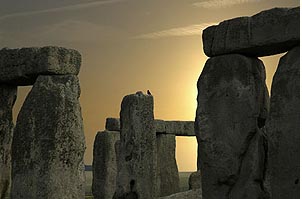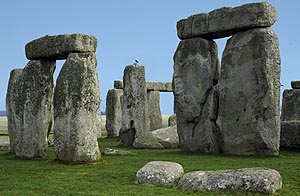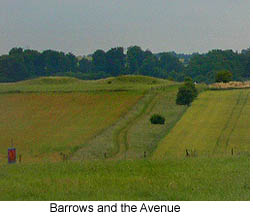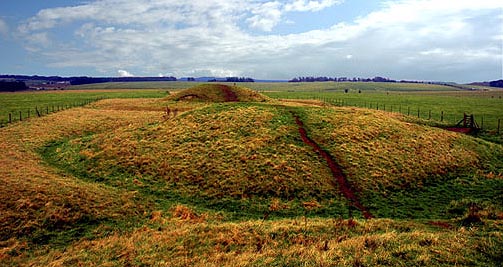Stonehenge: The Giants' Dance
by Sue Kendrick
They call this place the Giants' Dance and say a wizard built it with stones he stole from Erin. By his arts, he flew them through the air and set them down on the great plains of Salisbury and made a ring of power to endure forever.

The wizard was no conjuror of cheap party tricks, but Merlin, Arch-Druid of all Albion and the Giants Dance -- Stonehenge, built, according to Geoffrey of Monmouth, to commemorate the treacherous slaying of Vortigern at nearby Amesbury by Hengist the Saxon.
A likely tale? Of course, but it is just this kind of mystique that has given this broken ring of stones its hypnotic appeal and turned it into a major World Heritage site.
It is set amongst hundreds of acres of rolling downland where the sky tumbles and streams in an ever-changing shift of boiling cloud and shrouded horizons. Coming upon the stones during such times, few can fail to be moved by the imposing sight of these massive boulders, which, strangely, seem dwarfed by the landscape but still manage to evoke a skin-crawling sense of having slipped through the veil into a another realm.
 It's not quite so farfetched as it may seem. Stonehenge's history has no known beginning, and during the long ages, these stones have seen many races rise and countless kingdoms fall. Built in three phases, the earliest detectable trace of the circle dates back to 3,050 BC, with the construction of a circular ditch and bank (henge). Somewhere around 2,600 BC, a wooden structure was built in the centre. Between 2,500 and 1,500 BC, stones took the place of wood and were arranged and re-arranged several times during this period.
It's not quite so farfetched as it may seem. Stonehenge's history has no known beginning, and during the long ages, these stones have seen many races rise and countless kingdoms fall. Built in three phases, the earliest detectable trace of the circle dates back to 3,050 BC, with the construction of a circular ditch and bank (henge). Somewhere around 2,600 BC, a wooden structure was built in the centre. Between 2,500 and 1,500 BC, stones took the place of wood and were arranged and re-arranged several times during this period.
Constructed of two distinct types, the stones are both fascinating and intimidating. The largest are the Sarsens. These were brought from the Marlborough Downs nineteen miles away. This was quite an admirable feat in itself, given the nature of bronze age technology, but it's nothing compared to the skills and ingenuity needed to transport the smaller bluestones, which were erected first.
These originated in Wales -- the Preseli Mountains, which are themselves steeped in mysticism and legend. Leaving aside Merlin's magic powers, archaeologists think the ancient builders of Stonehenge used rafts and rollers to haul them 240 miles over land and up the Bristol Channel and the river Avon to their new home on Salisbury plain.
The stones were erected as outer and inner circles of trilithons (two stones with a third set across the top). Great skill was needed not only to hoist 40-50 ton of rock twenty feet into the air, but to ensure the stones fitted tightly together and would not fall once in place. The fact that several of these trilithons still stand in their original positions after 5,000 years is an astonishing testimony to the skill of their builders -- who, we are led to believe, ran around in animal skins wielding clubs and primitive axes!
A Host of Theories
Although reasonable conjecture can be made about the building of Stonehenge, almost nothing is known about who built it and, more importantly, why. Theories abound, the Merlin story as credible as many that are currently doing the rounds. Some, like John Aubrey, who discovered a range of small pits circling the stones, thought the druids were responsible. Historians, however, think this unlikely as no mention of the druids is made until the arrival of the Romans, thousands of years after Stonehenge was built. But who cares for historical accuracy? The Giants' Dance was ever a place for mystics, visionaries and dreamers, and almost all the conjecture surrounding the stones is of this ilk rather than the cold hard facts of science and archaeology.
 The Aubrey holes, say some, are in fact an ingenious way of plotting the phases of the moon and predicting eclipses, always portentous events and still held by modern astrologers as indicators of difficult times ahead. The stones themselves have been confirmed as being a kind of calendar with the altar stone aligned to the mid-summer sunrise, but true believers are sure that there is more to Merlin's ring of power than a mere plotter of the tides of sun and moon! Like many of Wiltshire's sacred sites, the stones lie on a ley line, linking with Old Sarum, Salisbury Cathedral and Clearbury Ring. Leys, so it is said, are earth currents or lines of power which our ancestors knew how to tap into and work to their advantage.
The Aubrey holes, say some, are in fact an ingenious way of plotting the phases of the moon and predicting eclipses, always portentous events and still held by modern astrologers as indicators of difficult times ahead. The stones themselves have been confirmed as being a kind of calendar with the altar stone aligned to the mid-summer sunrise, but true believers are sure that there is more to Merlin's ring of power than a mere plotter of the tides of sun and moon! Like many of Wiltshire's sacred sites, the stones lie on a ley line, linking with Old Sarum, Salisbury Cathedral and Clearbury Ring. Leys, so it is said, are earth currents or lines of power which our ancestors knew how to tap into and work to their advantage.
Unfortunately, apart from designated times such as the solstices, accessibility to the Stones is not something you are likely to get much of at present. During the early seventies, due to vandalism and increasing tourism, English Heritage took Stonehenge into its protection and, many would say, turned a profoundly mystical experience into a cash-jangling circus. It is no longer possible to walk amongst the stones or even gain access without parting with good hard cash, but at least the hideous wire cage that initially surrounded the site has been removed.
Earthworks and Barrows
Stonehenge is just a part of a surrounding landscape of prehistoric monuments. These momuments are many, and although perhaps not so dramatic as the Giants Dance, are just as fascinating. By far the best way to experience them is on foot, which you are able to do via a signposted walk that at present leaves through the car park.
 Head first for the Cursus, an unmissable rectangular earthwork set against the skyline. It runs on an east-west alignment and was built during the Neolithic period just slightly earlier than Stonehenge. Originally it was white and much higher. Now it is a grassy bank that makes for some fine views, so pause awhile and let the ambiance of the landscape seep into your soul. Visitors, which gather like flies around a honey pot at the Stones, are few here as the sharpish climb is a welcome deterrent to those who prefer a more sedentary life style.
Head first for the Cursus, an unmissable rectangular earthwork set against the skyline. It runs on an east-west alignment and was built during the Neolithic period just slightly earlier than Stonehenge. Originally it was white and much higher. Now it is a grassy bank that makes for some fine views, so pause awhile and let the ambiance of the landscape seep into your soul. Visitors, which gather like flies around a honey pot at the Stones, are few here as the sharpish climb is a welcome deterrent to those who prefer a more sedentary life style.
A long, gently sloping descent brings you to the Avenue and the approach route to the Stones. A low bank defines the route, but you can see it best from aerial photographs. It sweeps in from the river Avon 3k away and follows the line of the midsummer sunrise. In true Stonehenge fashion, mystery surrounds its purpose. Was it a ceremonial pathway for a long-dead religious rite? Or simply an access route for hauling the massive blue stones from the river during construction? Archaeologists confirm that it is contemporary to Stonehenge, but others claim that this was the processional route to the sacred marriage of Sun and Moon that would ensure plenty and prosperity to Merlin's isle of Gramayr!
Move on now to the King Barrows, which are ancient cemeteries lying on a prominent ridge to the east of the Stones. These burial mounds were built in the early Bronze Age and also include a Neolithic long barrow, which was raised between 4,000-3,000 BC. This long barrow is quite unusual since it runs north-south, while most barrows of this type are usually aligned east-west.

These barrows held the bones of entire families. The area around Stonehenge is littered with them, which is perhaps why some people call this place the landscape of the dead. There is no doubt that once away from the camera-dripping coach parties flocking around the Stones, there is a definite feeling of other-worldliness. The silence, space and ever-present wind whipping across the sheep-bitten turf combine to invoke a slightly disorientating effect of altered consciousness. The chatter of the mind stills and your subconscious opens to other thoughts and other visions. The huge skies seem somehow nearer here than other places. It can't be an accident, you think, that the horizon is a broken bowl-rim of tumuli and barrows. Could it be their makers knew a great truth, lost to us in these later years? That time is cyclic and that which goes away must one day return, much like the re-born sun after the winter solstice?
Related Articles:
- The Eternal Mystery of Stonehenge, by Pearl Harris
- https://www.timetravel-britain.com/articles/stones/stonehenge.shtml
- Amesbury: A Stepping Stone to History, by Pearl Harris
- https://www.timetravel-britain.com/articles/towns/amesbury.shtml
More Information:
We regret that we no longer have the resources to maintain up-to-date links and/or hours and pricing details for the various sites and attractions listed on this website. For more information about the location(s) listed above, please use your favorite search engine or visit Wikipedia.
Sue Kendrick is a freelance writer living in the English Midlands. She has written many special interest articles for magazines and newspapers and contributed an uncountable amount of news stories to her regional newspaper. She edits and publishes WriteLink (http://www.writelink.co.uk), a UK writers' resource website and monthly newsletter. She also writes fiction and has won several prizes for her short stories. When not writing, she likes to walk, ride, read and pursue her interest in small scale farming (not necessarily in that order!). For more information, visit http://www.suekendrick.co.uk.
Article and photos © 2005 Sue Kendrick
(Top photo and Avenue photo © 2003 Moira Allen)
|
